Sensing mechanical stimuli, temperature and pain LEcture 4
1/55
There's no tags or description
Looks like no tags are added yet.
Name | Mastery | Learn | Test | Matching | Spaced |
|---|
No study sessions yet.
56 Terms
Detecting mechanical stimuli is fundamental for sensing…
Hearing
touch
balance
proprioception
Sensing stomack or bladder distenction
osmotic pressure
arterial pressure
How are mechanical stimuli sensed?
directly by ion channels
BUT
little is knwon about the molecular machinery
How do ainimals sense physical contact
Mechanoreceptors of their body surface
How do aquatic creates detect movement and pressure changes in the water
The lateral line system
Lateral line system strucuture
Mechanoreceptors→ Neuromasts
Arranged in an interconnected netword
along the head and body
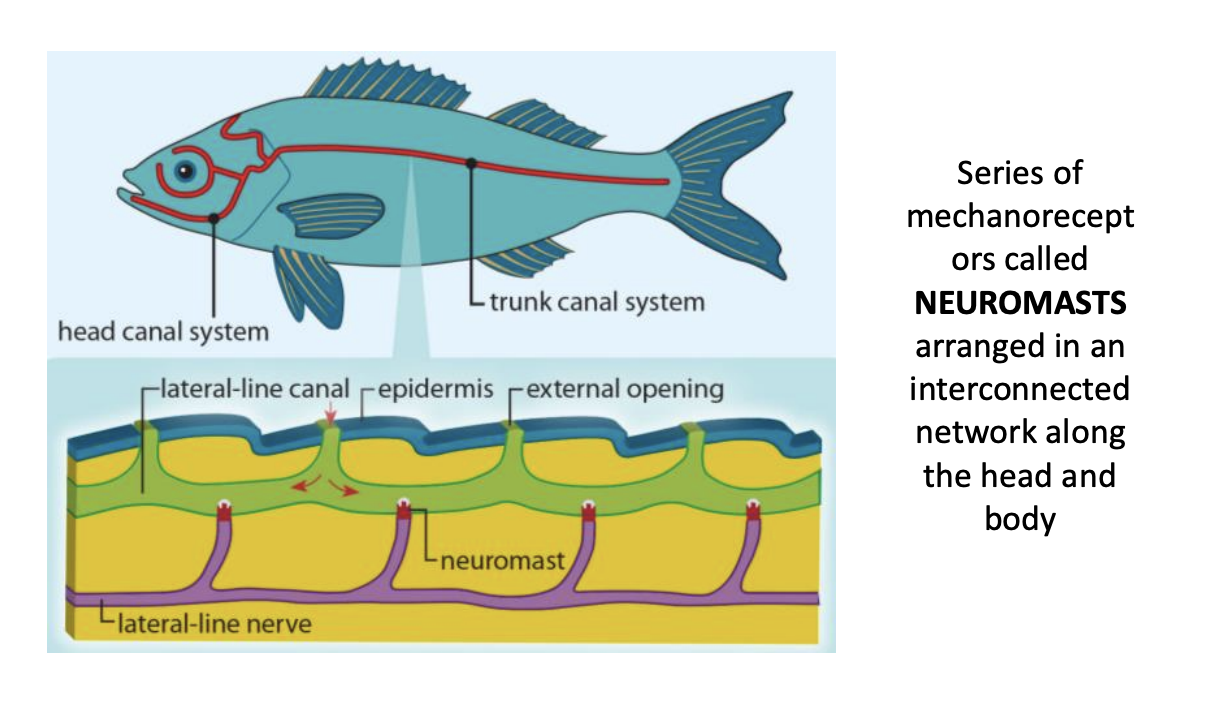
Constrasting to marine creates, terrestrial vertebrates must…
sense vibrations in the air
How did the lateral line evolve in to the inner ear
Most rostral part of the lateral line evolved into
the inner ear
cochlea (meachnosensory organ responsible for hearing
balance (semicircular canalas and vestibular organ)

Why is this evolution hypothesessied: evidence
Lateral line and inner ear share the same meachnorecpetors: Hair cells
Mechanotransduction in the inner eat occurs in liquid-filled cavities
endolymph
Alternate explanation for this?
convergent evolution
Hair cells→ where found
vestibular apparatus → balance
cochlea→ hearing
lateral lines of fish→ waterbourne vibrations
Strucutre of the hair cells
Apex
hair bundle→ set of sterocilia (like microvissli)
gradually increase in height
Next to the largest of these is→ Kinocilium
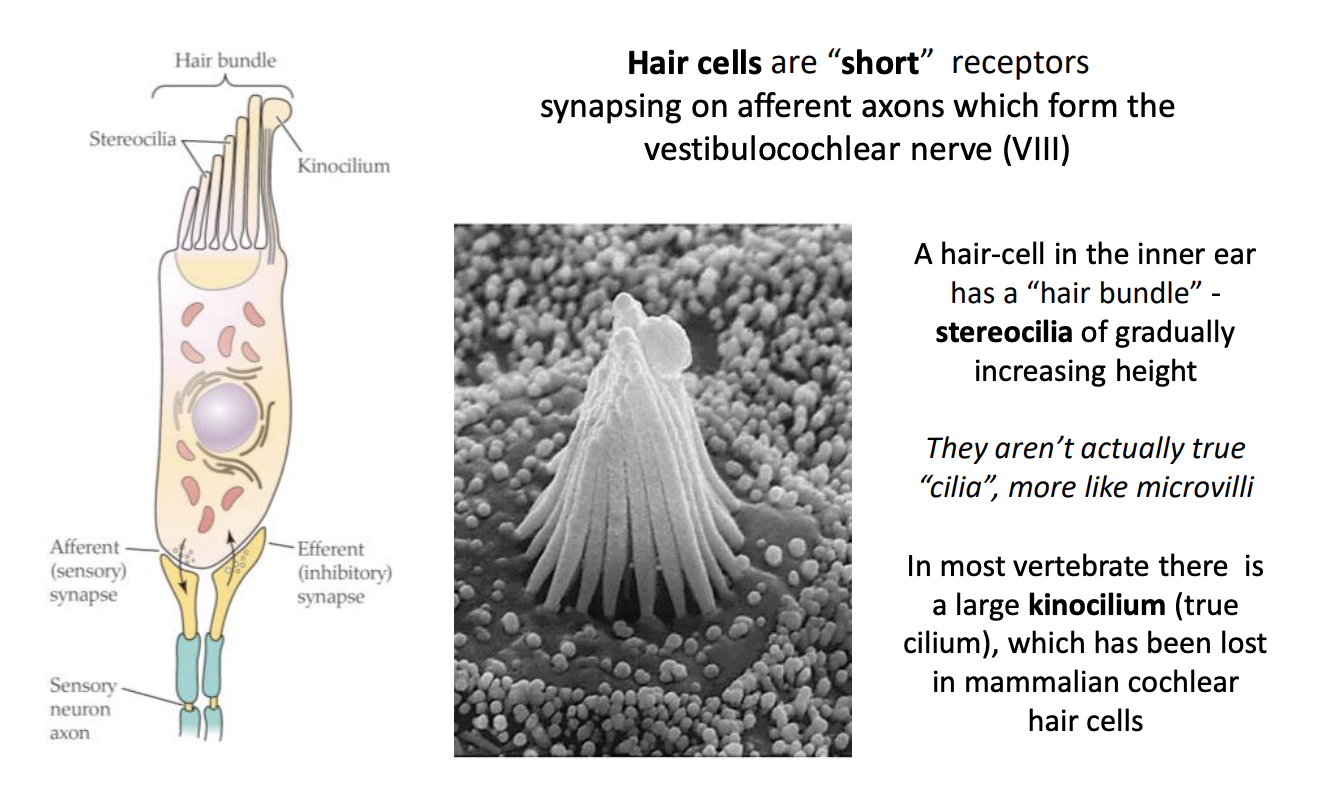
What happens when thebundle of sterocilia is bent in the direction of the largest one
Depolarised
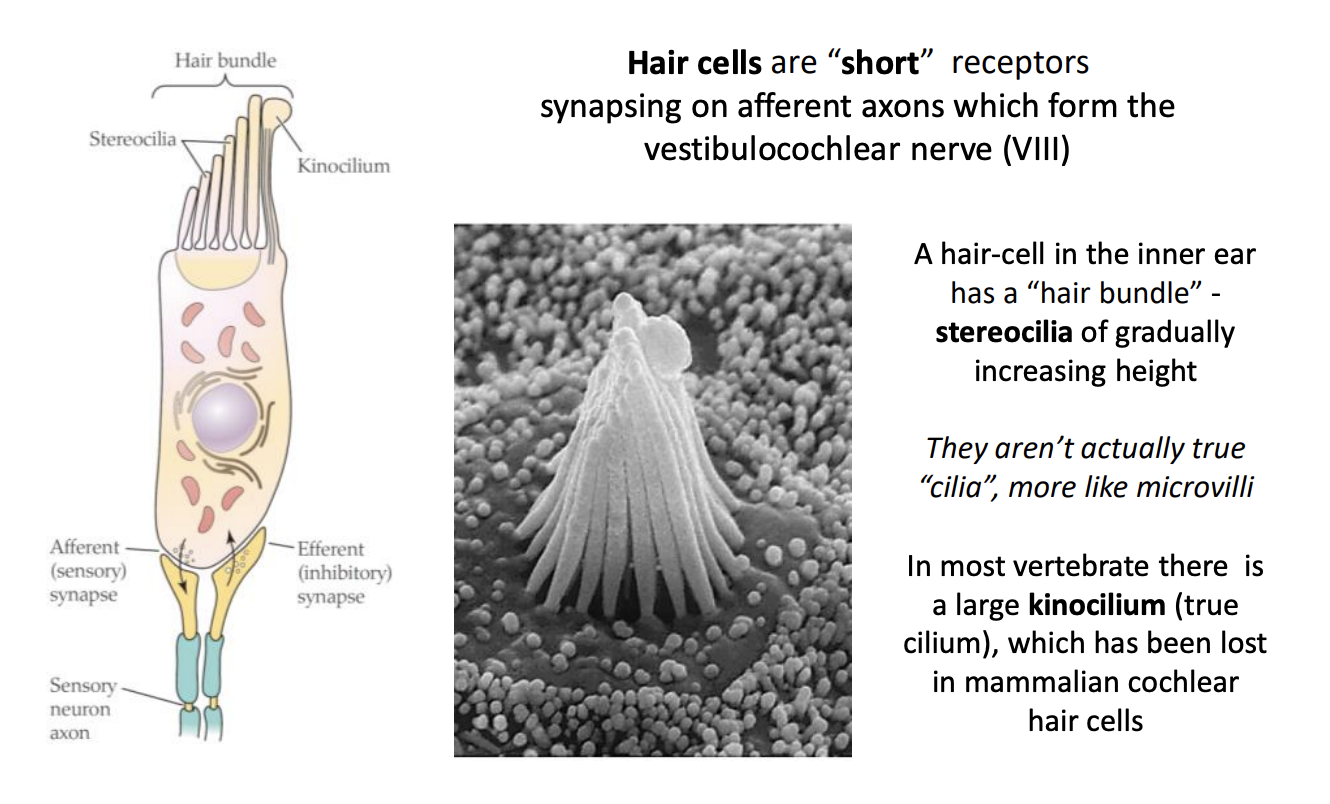
When bent in direction of the smallest one?
hyperpolarised
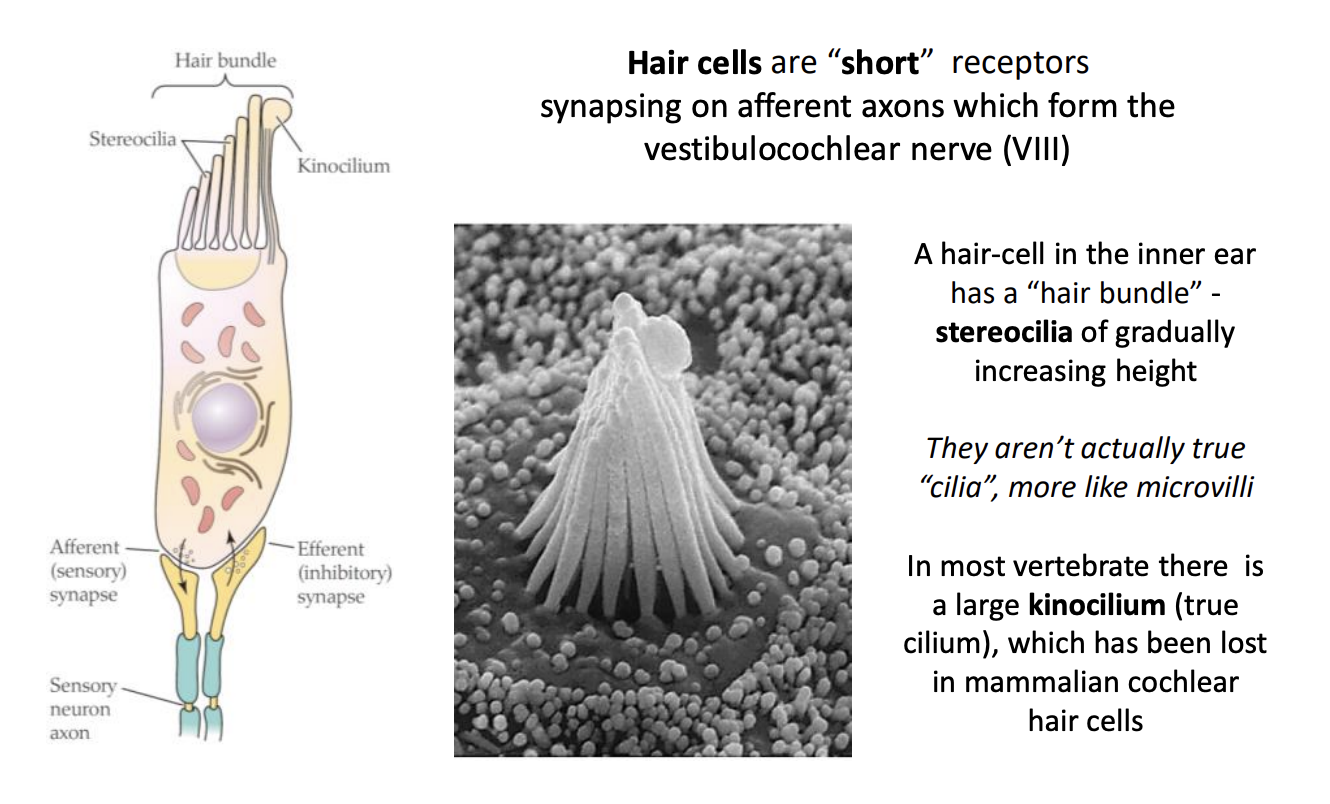
Therefore, how dot ehy detect any stimulus
from the deflection of the sterocilia in the right direction

Transduction: iono or metabotropic?
Ionotropic
Not G-proteins!!
much faster than that!
Transduction: How is depolarisation caused?
Thin tip links of cadherin connect the tip of each sterocilium to the shaft of the next longer neighbour
hair bundle deflected in direction of longer
tip links stretched
tension physically opens ion channels at the tips of sterocilia
Allow influx of cations
→ depolarisation → K+ enters the cell (the endolymph has very high K+
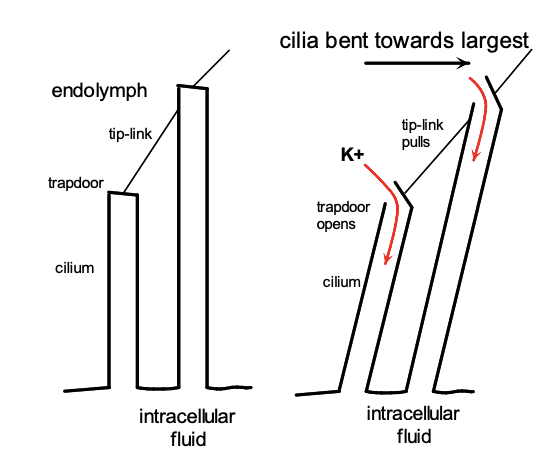
Wht is this channel?
Not really sure yest
maybe a complex of several proteins
non-selective ion channels
biggest net effect of its opeing is that K+ enters the cell
What happens to this depolarisation? encoding
Does not generate an action potential!
Leads to increaed released of transmitter vesciles
at presynaptic terminals at the base of the cell
onto primary afferent neurons
How much of a deflection is needed to do this?
1/15 degree in the angle of the % um sterocila
cause a noticeable change in membrane potential and transmitter release
Contrast to olfactory/photo receptors
Hair cells are all pretty much the same!!!
unlike
The 350-1000 different protein receptor types in olfactory receptors
3 different types of cones we have
If they are all the same, how do they respond to different things in different organs
e.g gravity, sound tones, vibrations in water
Use: different accessory strucutures
determine which mechanical stimuli actually result in deflection of the hair cell bundles
E.g of parts of the inner ear and what they detect
Vestibular→ linear acceleration (gravity)
Semicircular canals→ rotational/angular acceleration and movements
Cochlea→ Sound vibrations
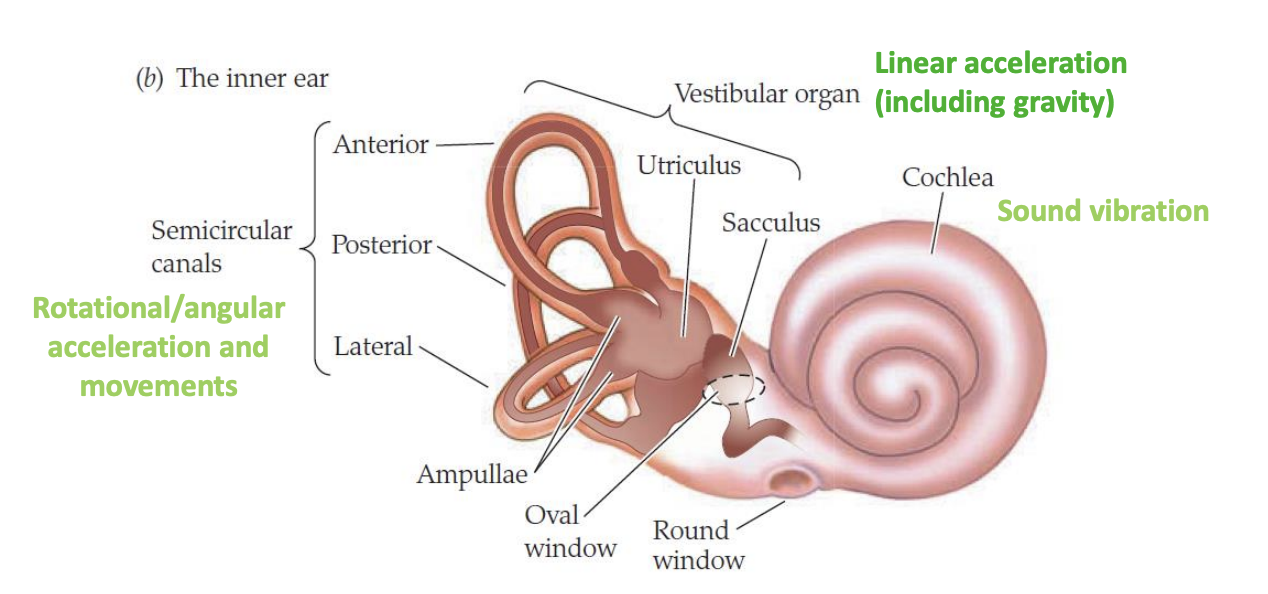
Vestibular organs (gravity)→ strucutre
Saccule and utricle arranged at right angles
what consist of:
Array of hair cells BUT oritenated in different directions
embedded in gel→ DENSER than the endolymph
contains calcium carbonate crystals (otoliths)
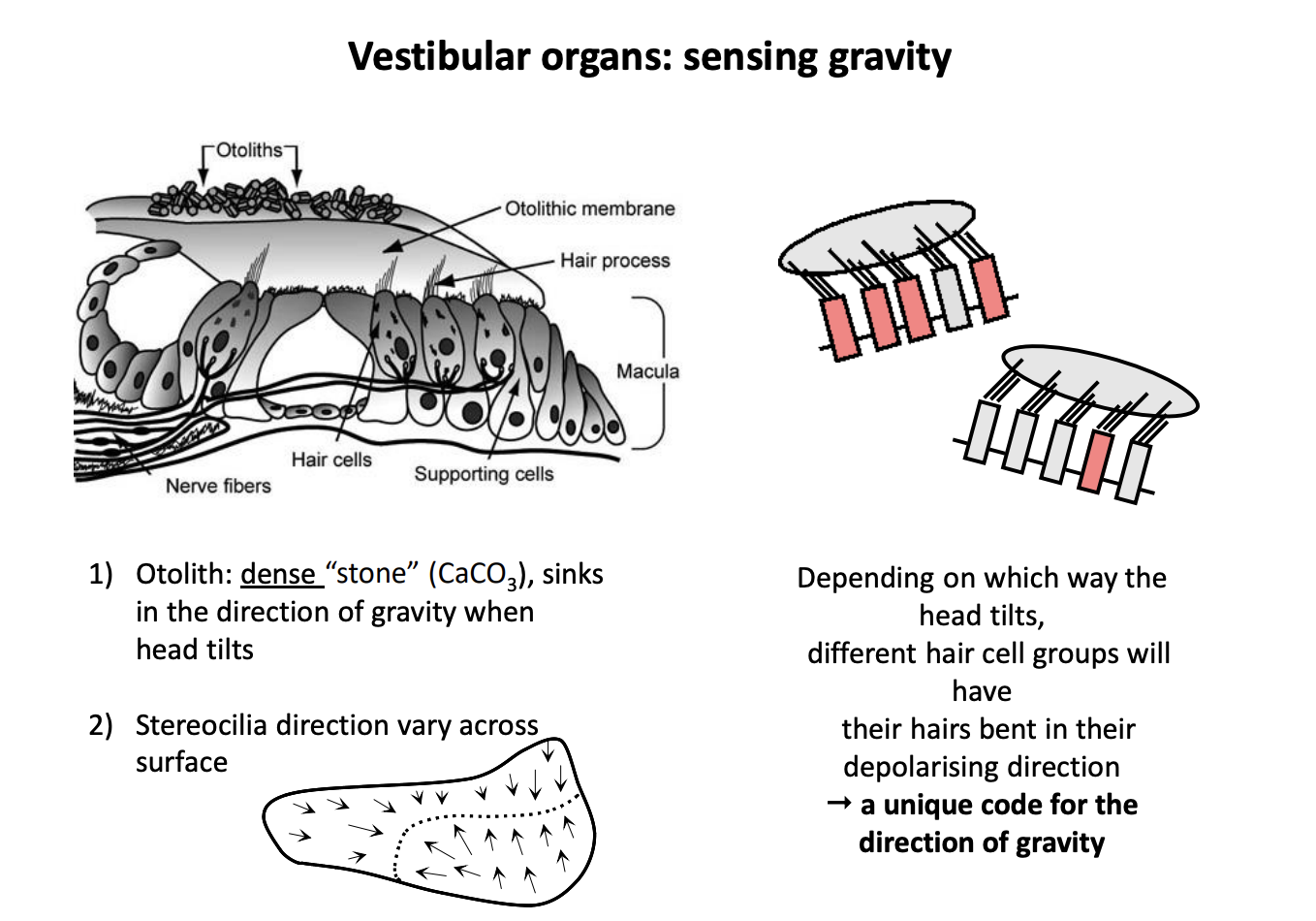
What is the role of otoliths and detecting gravity!
Head is tilted
otolith sink undergravity
bends all the hair bundles in the direction of tilt
depolaristes that subset of hair who sterocilia are in the approraite direciton
BUT
those not in the position→ will be hyperpolarised
OVERALL different head tilts→ different unique codes for the direction of gravirt!
Similarities with plants?
Use statoliths→ to detect gravity
→ BOTH: depend on dense strucutres sinking in fluid
Once detected, how is reponse coordinated
send neural messages to the brain
evalulates them against other information about head posture (visual cues)
almost like a calibration
then
sends reflec efferent signals to the appropriate neck or limn muscles
corect posutre and stop you from falling over!
Compare this reponse to plants?
statoliths accelerate flux of growth-inhibiting auxin
Semicircular canals: sensing angular motion→ strucutre
3 semicircular canals
orientated at right angles to each other (x,y,z axes)
detect angular motion of the head
How do they do this?
1. clusters of hair cells found at the base of each canal in an ampulla
sense the fluid movement around the canal
Compare the outsputs of the three canals→ accutate estimate of angular movements in 3 DIMENSIONS
Inner ear and Cochlea→ detecting sound vibrations, but with liquid?
Sound vibrations of the ear drum→ virbtrations BUT
inner ear is filled with endolymph
BUT PROBLEM
- airborne sounds are all reflected when they strike a liquid surface
How is this solved
Middle Ear
Ossicles (malleus, incus and stapes) in the air-filled tympanic middle ear
→ Allow air-borne sound energy to get to the cochlea!
Where is this middle ear found in organims
frogs, reptiles, birds and mmamls
BUT needed of aquatic species
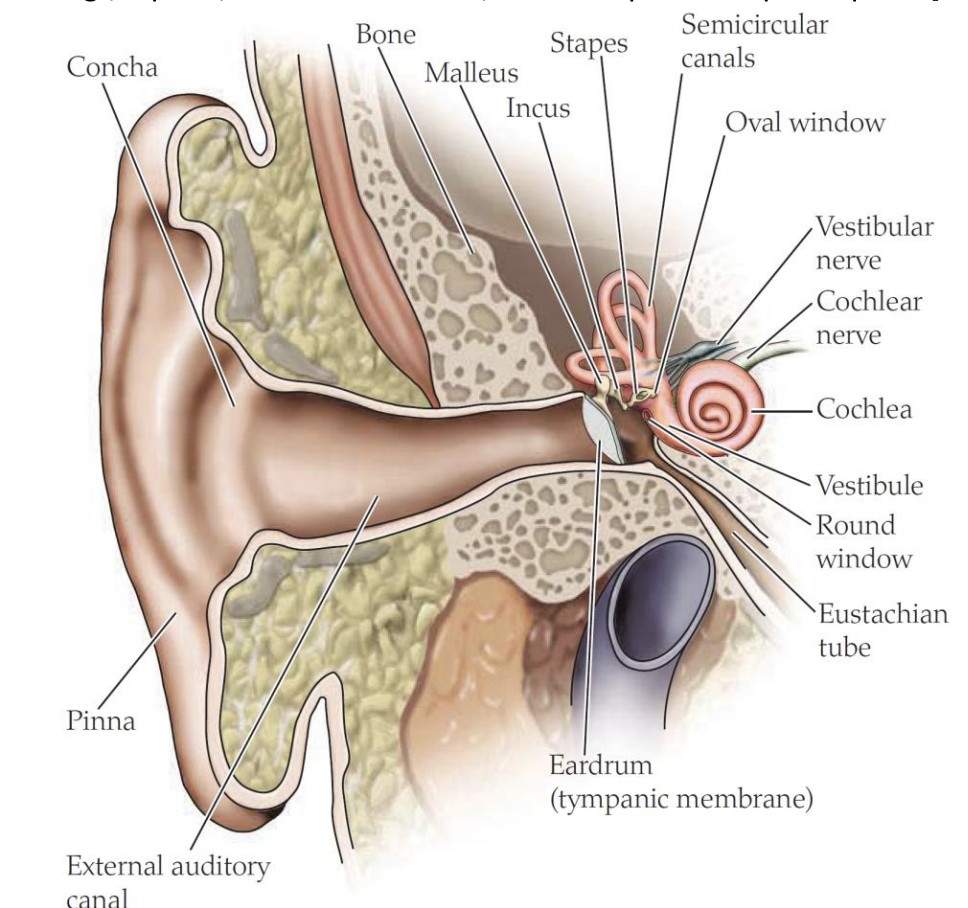
Now air born sounds can get through, how does the cochlea sense sound (strucutre)
Has 3500 inner hair cells
laid out in a single row along the length of a flexible 30mm membrane
basilar membrane
Sterocilla loosley embedded in the overlying tectorial membrane
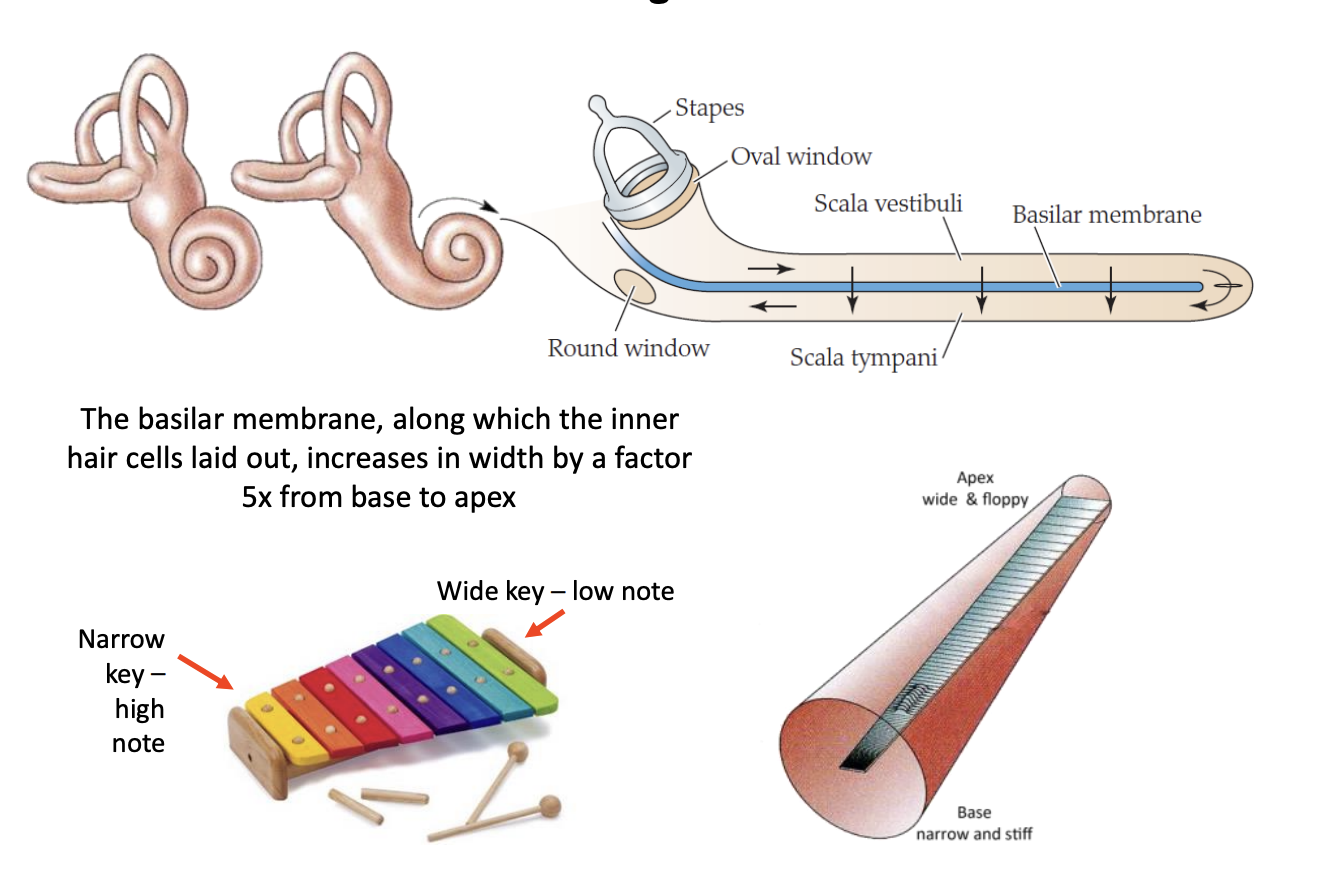
Strucutre of basilar membrane and how it can sense different frequencies
Width gradually increases from base to apex
Thin peice vibrates/ resolates at a higher frequency than a thicker peice
When a higher tone present→ naow basal part will responate
→ these specific inner hair cells get activated

What happens when sound is detected
Basilar membrane vibrates in time with the sound waves
hair bundles on the hair cells deflect to and fro (in time with sound waves)
Whichever freuency it was, corresponding width of the basilar membrane will vibrate
So even though teh hair cells are the same, they response to different tones due to their different locations
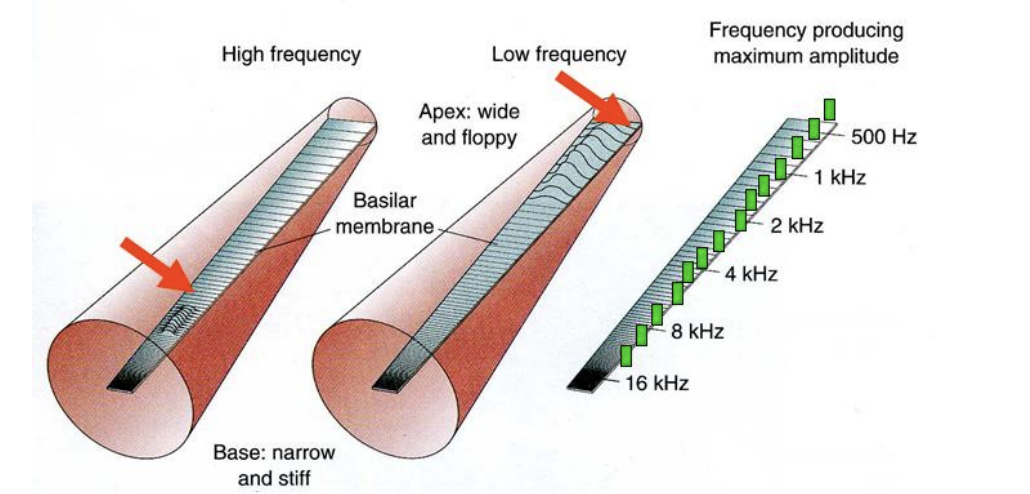
How does the basilar mmebrane filter sound (and act like auditory prism)
different tone freunqcies of different groups of hair cells
acitivate different groups of inner hair cells
→ can filter out from 20 to 20kHz
How is this sound freunciy detection passed on
Each inner hair cell communicates synaptically with
several afferent nerve fibres (which do not contact any other hair cells)
Has own set of personalised afferent nerve fibres!
Overall: detet specific frenecy→ encode for specific frequency
Activity in ‘x’ particular nerve fibres→ ‘x’ particular frequency is being playwed
What is the mechanism called
Labelled lines coding meachnism
Can plants hear sounds?
Seem to be able to sense specific vibrations
e.g caterpillars
Can plants make sounds
Apprently they get stressed with chewing sounds!
Different things we must detect in out skin (somatosensation)
light touch
vibration
pressure
nociception
All use different sensitive receptors
Types of mechnosensitive response in skin
Meissner corpuscles
Merkel cells
Ruffini endings
Pacinian corpuscles
free nerve enedings

How do these all differ?
morphology
innervation pattern
location in the skin
receptive field sie
phyiological response
But they all transduce the signal the same
ion channels in the nerve terminals are activated
by mechnical stimuli
DUE TO
Stretch or Deform the cell membrane
Directly
or
via linker proteins
THEN→ mechanical displacement leads to ion channel opeing and depolsiation!
Overall how tranduce signal
Stretch or deform ion channels (mechnosensitive ion channels)
directly
or via linker proteins (spring open thingy)
Opens channels
Depolarisation
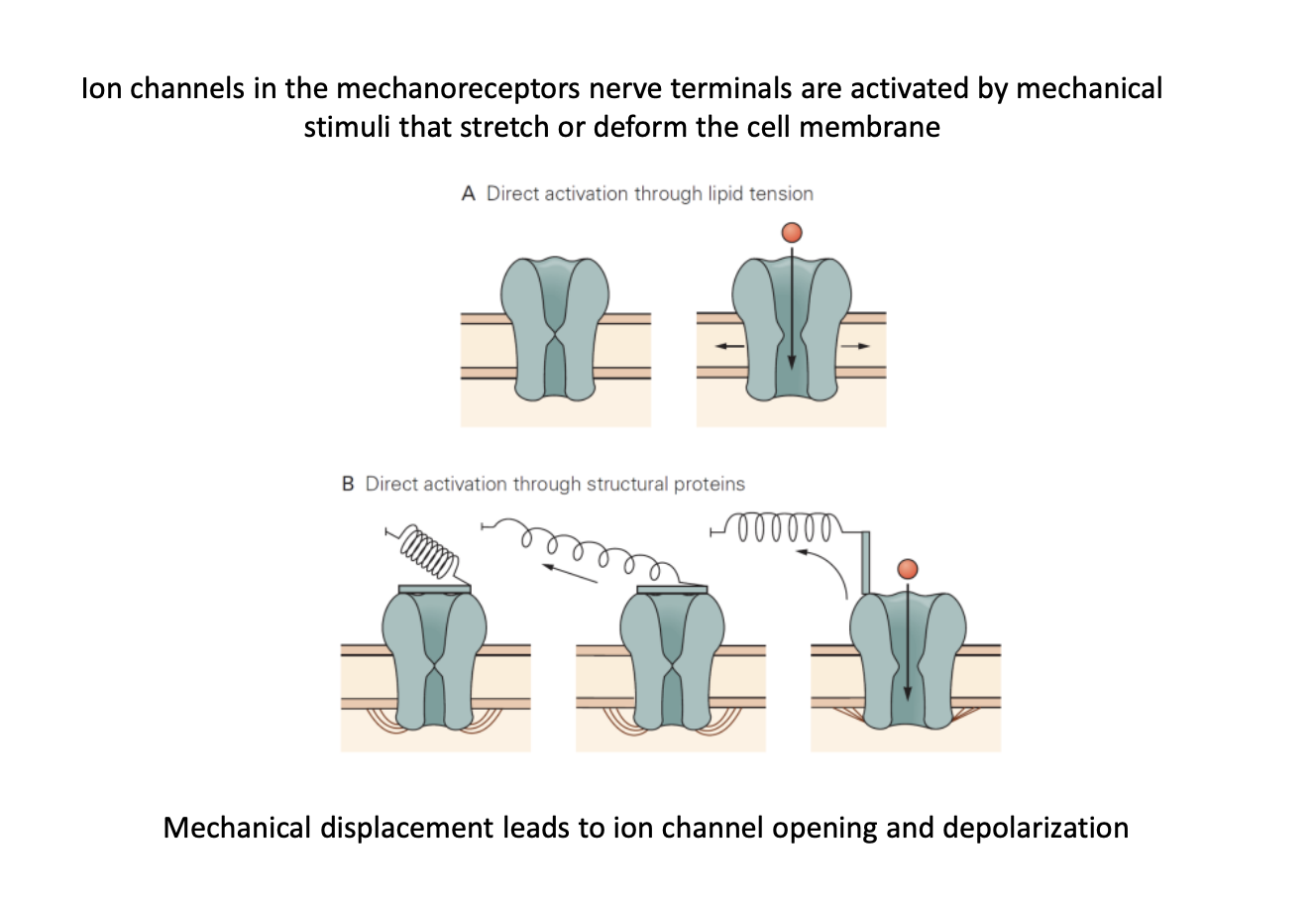
What are these meachnosensitive ion channel?
Piezo channels
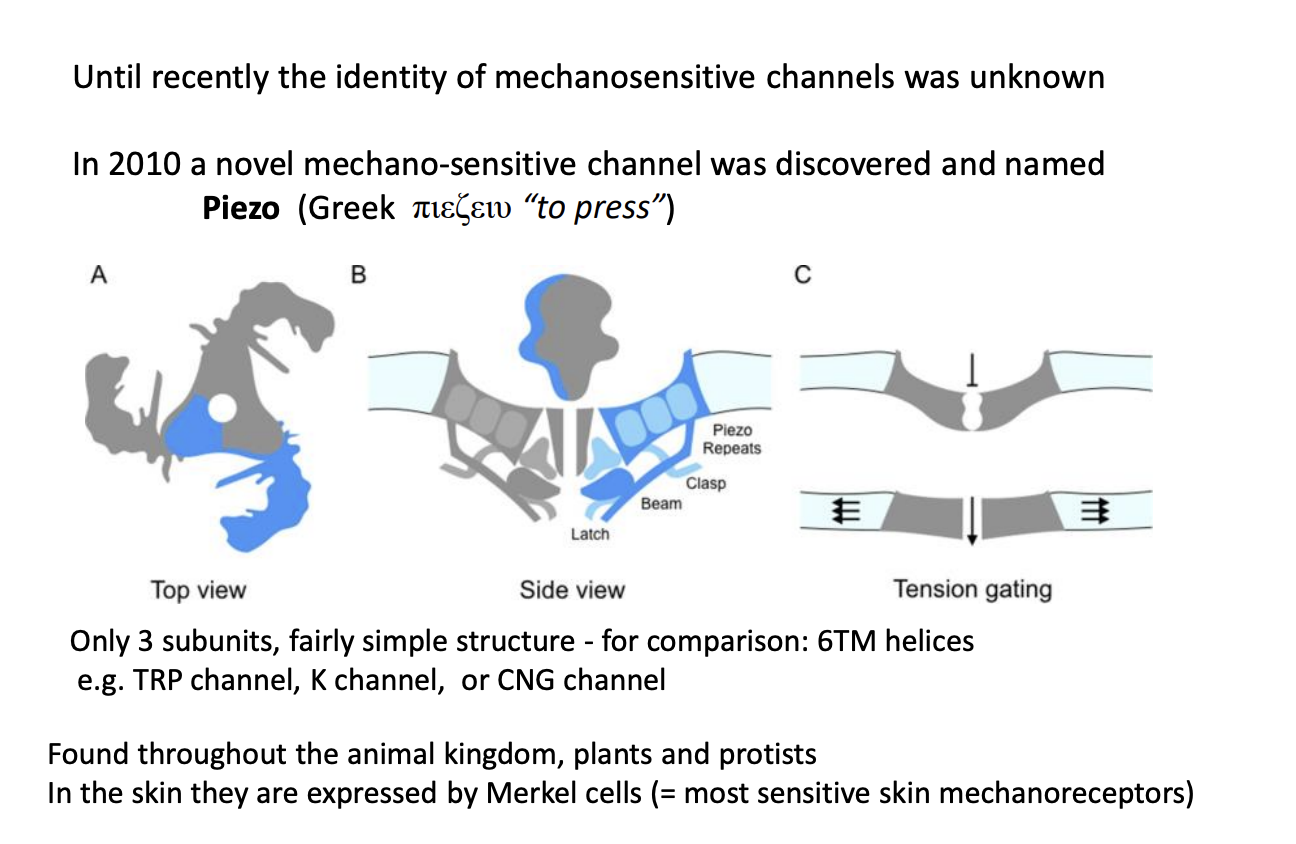
What are Piezo channels used by?
Merkel cells→ the most sensitive mechanoreceptor cell

Strucutre of Piezo channels
largest proteins knwon
three subunits
but with 30 transmembrane helices
In plants and protists!
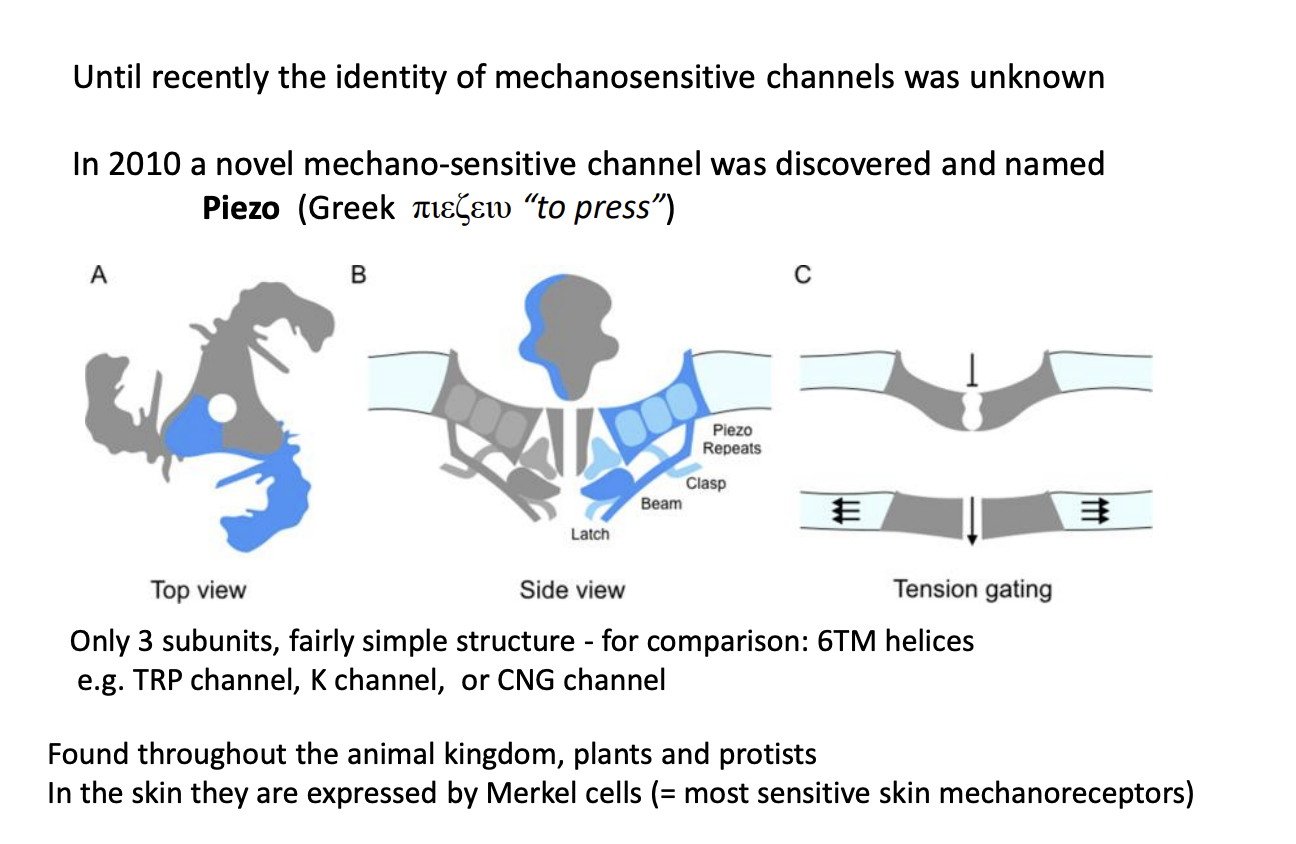
If all these touch receptors use ion channels, they most encode and adapt differently for specific sensations
Major differences in the speed of their adaptationn
FAST→ Meissner and Pacinian
SLOW→ Merkel and Ruffini

Touch in plants?
Mimosa pudica
Venus fly trap
Mixing up sensory modaliteies
Some taste sensing is done my touchin octupuses

How is temperature sensed?
Useing Transient Receptor Potential (TRP) ion channels
6 transmembrane domains proteins
gated by different temperates and/or chemical ligands
Where are they also used?
invertebrates photoreceptions
Features of TRPs
non-selective tetrameric cation channels
most with infinite Ca2+ permeability
Polymodal activation and regulation

How are they polymodal actiavted/regulated?
once channel is opened by several things
→ So have many phyiological roles nad found in many sensory receptors
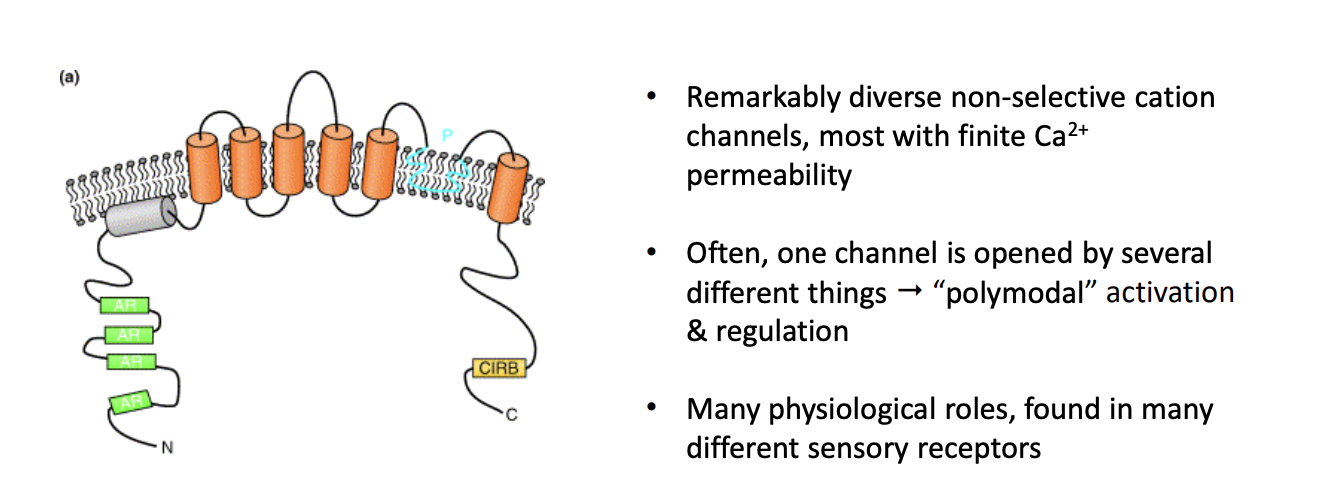
E.g TRPV1 in pain nerve enedings opened by
Chilli type chemicals
acid (H+)
nasty electrophilic chemicals (mustard)
mechanical stimuli
painfully hot/cold temperatures
indireclty by tissue damage
